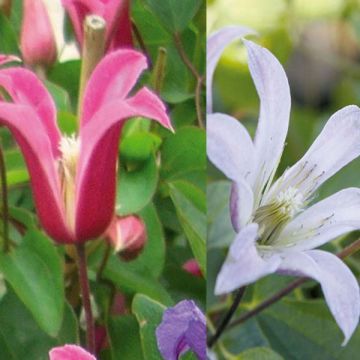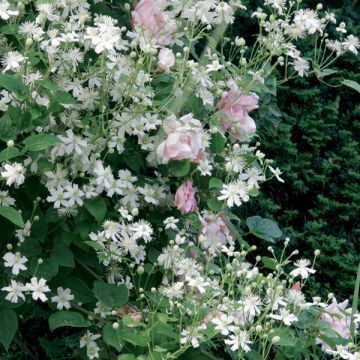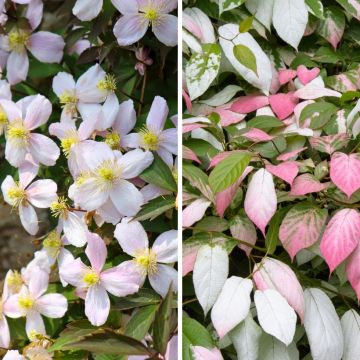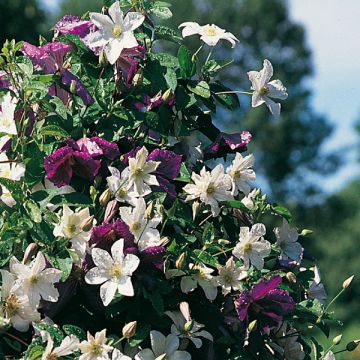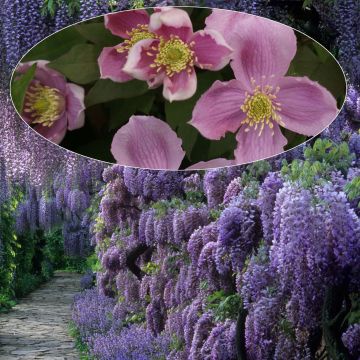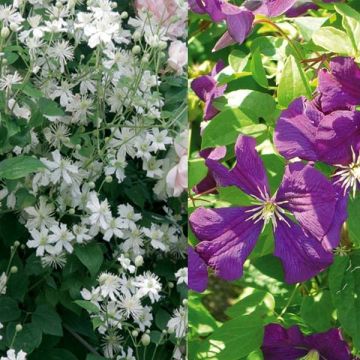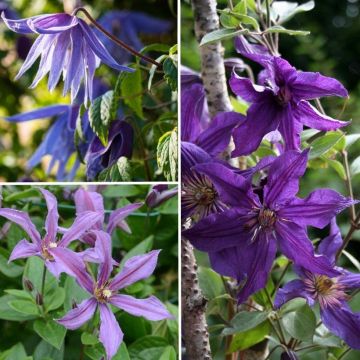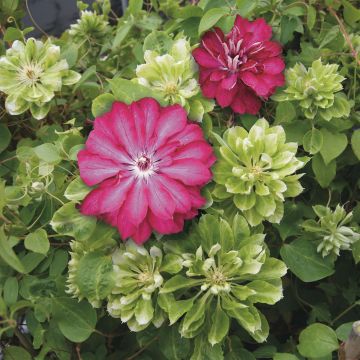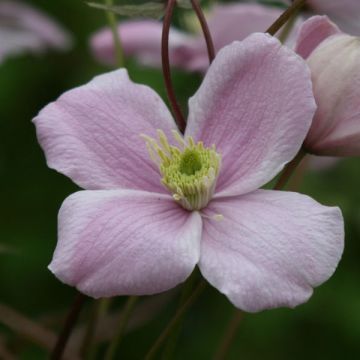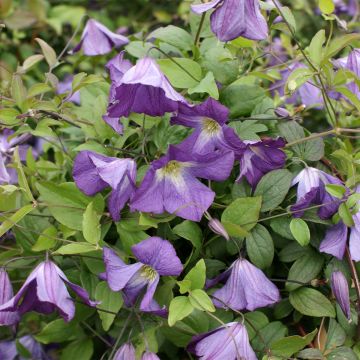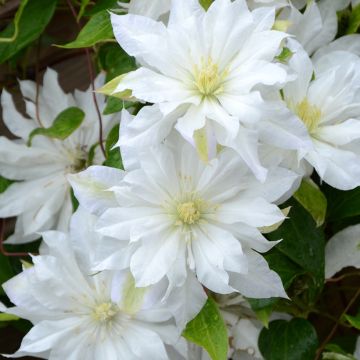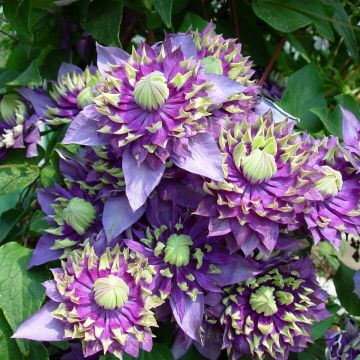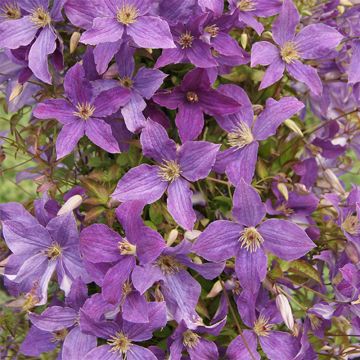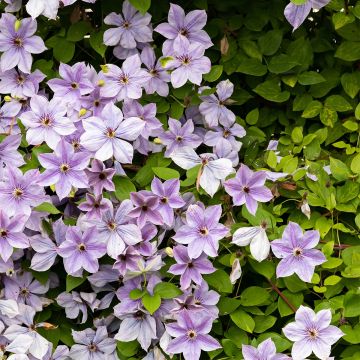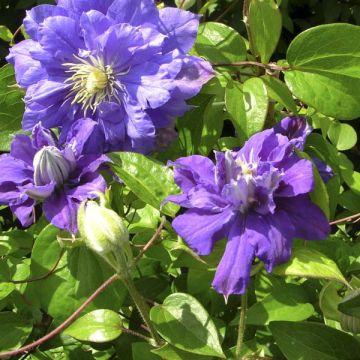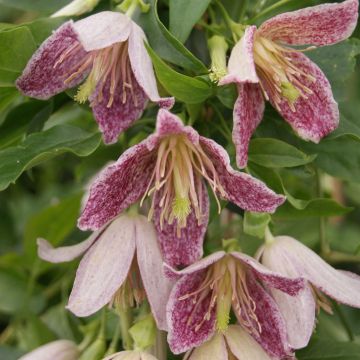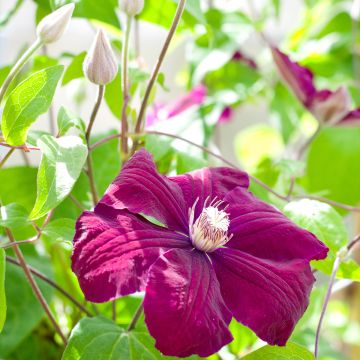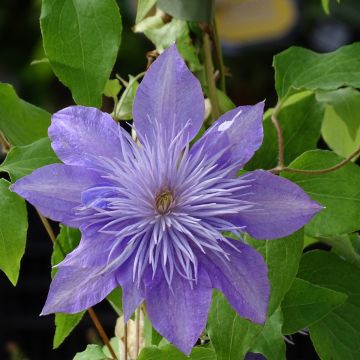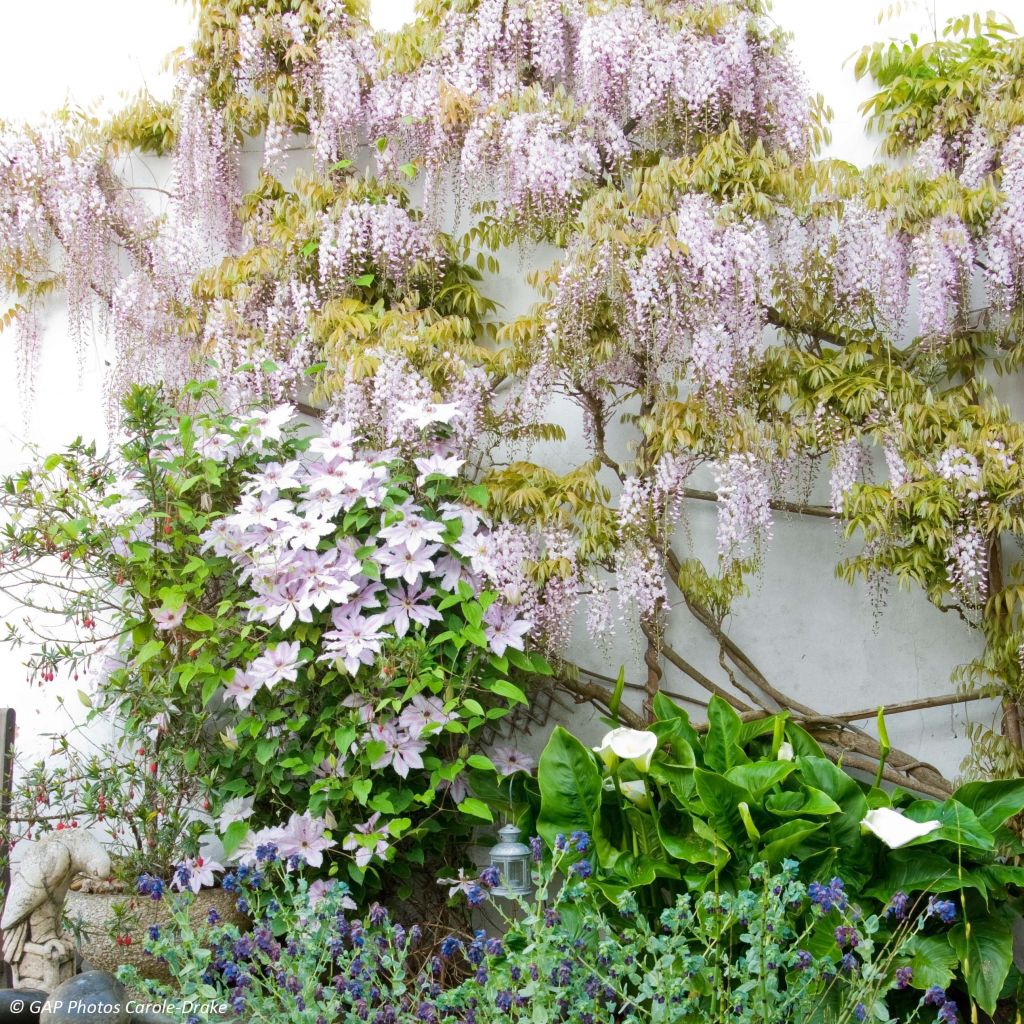

Sweet Duo - Clematis Nelly Moser and Chinese Wisteria in pink
Sweet Duo - Clematis Nelly Moser and Chinese Wisteria in pink
The lot includes a Chinese wisteria or a Japanese wisteria? The proposition is not very clear! We are talking about the Chinese wisteria and showing a photo of the Japanese wisteria... Please clarify.
Isabelle, 11/05/2022
This item cannot be shipped to the selected country
Delivery charge from €5.90
More information
Schedule delivery date,
and select date in basket
This plant carries a 6 months recovery warranty
More information
We guarantee the quality of our plants for a full growing cycle, and will replace at our expense any plant that fails to recover under normal climatic and planting conditions.
From €5.90 for pickup delivery and €6.90 for home delivery
Express home delivery from €8.90.

Does this plant fit my garden?
Set up your Plantfit profile →
Collection items (2 plants)
Description
A duo of climbing plants as charming as they are vigorous and easy to grow, whose pink flowers blend gently in spring. In April-May, for 3 to 4 weeks, the two-toned pink stars of the Nelly Moser clematis mingle with the tender and fragrant clusters of the pink Chinese wisteria. The clematis, with a rather compact habit, often blooms again in late summer, and the wisteria bears a few flowers in July-August among its light foliage. Let them take over a tree, or let them climb a trellis or a wire fence. The vigour of the wisteria will be controlled by a fairly severe pruning in late summer.
This duo consists of Clematis montana Nelly Moser and Wisteria sinensis Rosea.
Clematis Nelly Moser is an excellent hybrid. This vigorous woody climber, reaching approximately 3 m (10ft) in height, blooms early in spring, for about 3 weeks, and usually blooms again in late summer, with large single and star-shaped flowers that can reach 15 to 18 cm (6 to 7in) in diameter, composed of white-pink petals marked with a broad pink, almost carmine, central line. They give way to feathery and silvery decorative fruits until late winter. This very old variety is reliable and easy to grow.
The pink Chinese wisteria, Wisteria sinensis Rosea in Latin, is an exuberant climbing plant, its long stems, which can reach 10 to 20 m (33 to 66ft) in length, lignify with age. They bear leaves divided into numerous light green rounded leaflets, giving the foliage a light appearance. The main flowering takes place in April-May, more or less early depending on the climate, at the same time as the clematis. It develops on almost naked branches located near the main woody stems. These are clusters of pale pink flowers, 30 cm (12in) long, which spread a sweet and flowery fragrance in calm weather.
Both are deciduous plants in winter, perfectly resistant to cold, undemanding in terms of soil (although the Wisteria fears excessive limestone and Clematis montana does not like too dry soils in summer). They will thrive in any good deep and well-drained garden soil and in a sunny to semi-shaded exposure.
Install this duo in an informal hedge, place each plant on either side of a long solid trellis, or let these two vines freely take over a tree. The combination of clematis and Chinese wisteria is one of the most romantic. These queens of climbing plants are capable of enhancing any structure, no matter how modest, sometimes ignoring the limits of your garden. Often surviving in old gardens from the time they were planted, left to themselves, they are loyal and extremely durable plants. To extend their wonderful flowering, you could associate this duo with a fragrant climbing rose like 'Felicia', 'Crown Princess Margareta', or 'Matine Guillot' for example.
Report an error about the product description
Plant habit
Flowering
Foliage
Botanical data
Cultivar or hybrid
Other Clematis collections
Planting and care
Clematis Nelly Moser: choose a position with morning sun or partial shade, or even a north-facing aspect. Shade the base of your clematis with a groundcover plant, a perennial geranium or even a tile, a log, or any material that will keep the base of the plant in the shade, without impeding air circulation. Clematis like to have cool feet. Plant your clematis by covering the root ball with 3 cm (1in) of soil, in a well prepared soil to a depth of 20 cm (8in), lightened with good compost. During the first few weeks, water abundantly and regularly. Clematis cling by themselves thanks to their tendrils. To promote their growth, offer them a trellis support or let them climb the trunk of a tree by adding a wire mesh. Clematis also like to grow freely on neighbouring plants. You can prune it in April up to 1 m (3ft) in height. We advise against overwatering, as stagnant water can cause fungus at the base of the clematis.
Chinese Wisteria is an easily cultivated plant in all our regions, as long as the soil it is planted in is sufficiently deep. It grows in any garden soil, with a preference for poor soils. However, it prefers an acidic to neutral soil and may wither in limestone soil. Once established, it withstands summer drought perfectly and requires no watering at all. Plant it along a wall or train it on a pergola. Pruning is recommended to achieve better flowering. To improve the hardiness of Wisteria chinensis, plant it in a sufficiently well-drained soil, trained on a south-facing wall, it will withstand very harsh winters more easily. Wisterias can be trained as trees by growing them up a 1.5 to 2m (5 to 7ft) stake, or as groundcover.
Planting period
Intended location
Care
-
, onOrder confirmed
Reply from on Promesse de fleurs
Clematis
Haven't found what you were looking for?
Hardiness is the lowest winter temperature a plant can endure without suffering serious damage or even dying. However, hardiness is affected by location (a sheltered area, such as a patio), protection (winter cover) and soil type (hardiness is improved by well-drained soil).

Photo Sharing Terms & Conditions
In order to encourage gardeners to interact and share their experiences, Promesse de fleurs offers various media enabling content to be uploaded onto its Site - in particular via the ‘Photo sharing’ module.
The User agrees to refrain from:
- Posting any content that is illegal, prejudicial, insulting, racist, inciteful to hatred, revisionist, contrary to public decency, that infringes on privacy or on the privacy rights of third parties, in particular the publicity rights of persons and goods, intellectual property rights, or the right to privacy.
- Submitting content on behalf of a third party;
- Impersonate the identity of a third party and/or publish any personal information about a third party;
In general, the User undertakes to refrain from any unethical behaviour.
All Content (in particular text, comments, files, images, photos, videos, creative works, etc.), which may be subject to property or intellectual property rights, image or other private rights, shall remain the property of the User, subject to the limited rights granted by the terms of the licence granted by Promesse de fleurs as stated below. Users are at liberty to publish or not to publish such Content on the Site, notably via the ‘Photo Sharing’ facility, and accept that this Content shall be made public and freely accessible, notably on the Internet.
Users further acknowledge, undertake to have ,and guarantee that they hold all necessary rights and permissions to publish such material on the Site, in particular with regard to the legislation in force pertaining to any privacy, property, intellectual property, image, or contractual rights, or rights of any other nature. By publishing such Content on the Site, Users acknowledge accepting full liability as publishers of the Content within the meaning of the law, and grant Promesse de fleurs, free of charge, an inclusive, worldwide licence for the said Content for the entire duration of its publication, including all reproduction, representation, up/downloading, displaying, performing, transmission, and storage rights.
Users also grant permission for their name to be linked to the Content and accept that this link may not always be made available.
By engaging in posting material, Users consent to their Content becoming automatically accessible on the Internet, in particular on other sites and/or blogs and/or web pages of the Promesse de fleurs site, including in particular social pages and the Promesse de fleurs catalogue.
Users may secure the removal of entrusted content free of charge by issuing a simple request via our contact form.
The flowering period indicated on our website applies to countries and regions located in USDA zone 8 (France, the United Kingdom, Ireland, the Netherlands, etc.)
It will vary according to where you live:
- In zones 9 to 10 (Italy, Spain, Greece, etc.), flowering will occur about 2 to 4 weeks earlier.
- In zones 6 to 7 (Germany, Poland, Slovenia, and lower mountainous regions), flowering will be delayed by 2 to 3 weeks.
- In zone 5 (Central Europe, Scandinavia), blooming will be delayed by 3 to 5 weeks.
In temperate climates, pruning of spring-flowering shrubs (forsythia, spireas, etc.) should be done just after flowering.
Pruning of summer-flowering shrubs (Indian Lilac, Perovskia, etc.) can be done in winter or spring.
In cold regions as well as with frost-sensitive plants, avoid pruning too early when severe frosts may still occur.
The planting period indicated on our website applies to countries and regions located in USDA zone 8 (France, United Kingdom, Ireland, Netherlands).
It will vary according to where you live:
- In Mediterranean zones (Marseille, Madrid, Milan, etc.), autumn and winter are the best planting periods.
- In continental zones (Strasbourg, Munich, Vienna, etc.), delay planting by 2 to 3 weeks in spring and bring it forward by 2 to 4 weeks in autumn.
- In mountainous regions (the Alps, Pyrenees, Carpathians, etc.), it is best to plant in late spring (May-June) or late summer (August-September).
The harvesting period indicated on our website applies to countries and regions in USDA zone 8 (France, England, Ireland, the Netherlands).
In colder areas (Scandinavia, Poland, Austria...) fruit and vegetable harvests are likely to be delayed by 3-4 weeks.
In warmer areas (Italy, Spain, Greece, etc.), harvesting will probably take place earlier, depending on weather conditions.
The sowing periods indicated on our website apply to countries and regions within USDA Zone 8 (France, UK, Ireland, Netherlands).
In colder areas (Scandinavia, Poland, Austria...), delay any outdoor sowing by 3-4 weeks, or sow under glass.
In warmer climes (Italy, Spain, Greece, etc.), bring outdoor sowing forward by a few weeks.



































